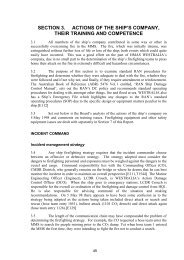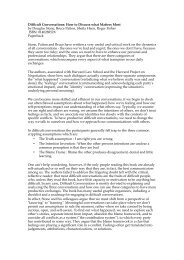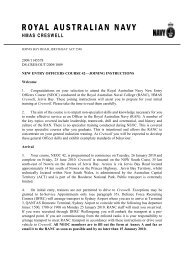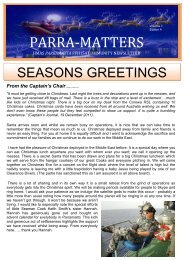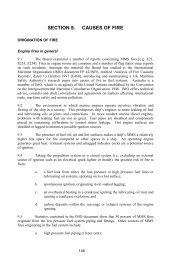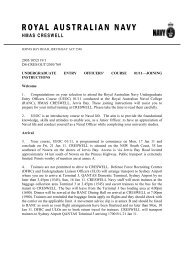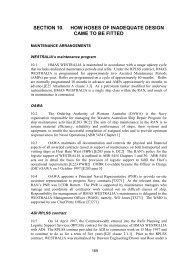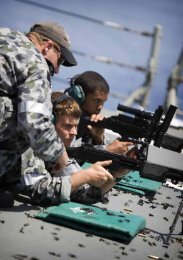30955 DEFENCE Mitchell Essay 02 - Royal Australian Navy
30955 DEFENCE Mitchell Essay 02 - Royal Australian Navy
30955 DEFENCE Mitchell Essay 02 - Royal Australian Navy
Create successful ePaper yourself
Turn your PDF publications into a flip-book with our unique Google optimized e-Paper software.
The <strong>Royal</strong> <strong>Australian</strong> <strong>Navy</strong> in<br />
the Twenty First Century—<br />
Strategic Thoughts<br />
Commander Adeniyi Adejimi Osinowo,<br />
Nigerian <strong>Navy</strong><br />
In the course of its history and developments within the past two centuries,<br />
the term naval strategy has attracted numerous scholarly attention and<br />
definitions. Admiral Alfred Thayer Mahan and, more remarkably, Sir Julian<br />
Corbett helped in demarcating naval strategy from its confusing representation<br />
with maritime strategy. While the more encompassing maritime strategy is<br />
fundamentally exploitative, naval strategy could be regarded as protective,<br />
pressure inducing and force projection oriented across geographic, economic,<br />
legal, military and diplomatic dimensions. The study of naval strategy easily<br />
evidences the view that past naval strategists drew much inspiration from<br />
past history of naval warfare, particularly from the successes and failures of<br />
naval powers. Interestingly, prominent strategic views of naval operations so<br />
far have emanated mainly from the big powers environment and perspective.<br />
Therefore, the fact that the contemporary maritime environment has<br />
proliferated with numerous medium and smaller navies necessarily demands<br />
a home-grown approach to modelling and employment of naval forces. The<br />
compelling diversification of maritime activities along physical, economic,<br />
military, legal and political dimensions, particularly in the post-Second World<br />
War era, further justifies the need to customise naval strategy.<br />
For the <strong>Royal</strong> <strong>Australian</strong> <strong>Navy</strong> (RAN), its emergence within the past century<br />
into a complex and dynamic maritime environment with major maritime<br />
responsibilities has made continuous strategic update an imperative. Curiously,<br />
within the past decade, it has been interesting to watch Australia’s strategic<br />
view of her maritime environment evolve from a position of ‘no immediate<br />
threat’ 1 to a conscious proactive stance on credible naval development as an<br />
instrument of national power. The articulation of a coherent <strong>Australian</strong> Maritime<br />
Doctrine (AMD) has been a welcome development in this direction.<br />
17<br />
2<br />
1 Sharpe, R. (editor), James Fighting Ships 1998-99 – Foreword, Janes Information Group Surrey,<br />
1999, p. 86.
18 PETER MITCHELL ESSAYS 2003<br />
Before delving into the strategic thoughts of past naval thinkers, it would be<br />
instructive to aggregate the discernible generic components of strategy.<br />
A strategy could be seen not only as a plan of action aimed at achieving specific<br />
objectives, the plan component could be further interpreted in terms of<br />
resources, concept of resource deployment and employment as well as<br />
sustainability of the plan. While expatiating on the ‘objective’ component,<br />
Liddell Hart stated that ‘the true purpose of strategy is to diminish the<br />
possibility of resistance’; 2 in this case, resistance to attainment of national<br />
maritime objectives which a naval strategy serves. This component definition<br />
will be employed in this discourse that focuses mainly on the works of Mahan,<br />
Corbett and Gorshkov.<br />
Alfred Thayer Mahan<br />
Mahan’s description of the sea as a wide common through which a navy must<br />
be capable of power projection and commerce protection has established its<br />
relevance. Along with Corbett, he emphasised command of the sea through<br />
der tag. 3 Also notable among his strategic views are coastal defence and force<br />
multiplication through alliance formation. His emphasis on a fleet with<br />
offensive and defensive capabilities is agreeable, particularly for medium and<br />
big powers. In his exposé on the principal seapower conditions, Mahan<br />
categorised island nations, such as Australia, as those that did not have to<br />
divert focus away from the sea. 4<br />
While recognising that the days of absolute sea control are over, it would also<br />
seem that Mahan’s view that the history of sea power is largely a military<br />
history can no longer be comfortably projected into the future of naval strategy.<br />
For instance, the wide acceptance and implementation of the Third United<br />
Nations Convention on the Law of the Sea (UNCLOS III) has emerged as a<br />
strong factor in strategic calculations of littoral states and their navies. 5<br />
Essentially, the conventions tend to protect non-littoral and weak littoral<br />
nations. Rather than promote military confrontation, its provisions have laid<br />
the foundation for peaceful and orderly maritime exploitation. Medium and<br />
smaller naval powers could be described as the major beneficiaries of these<br />
2 Liddell Hart, B.H., Strategy – 2 nd Edition, Penguin Books, 1991, p. 213.<br />
3 Jablonsky, D. (editor), Roots of Strategy Book 4, Stackpole Books, Mechanicsburg, 1999,<br />
pp. 48-51.<br />
4 Jablonsky, D. (editor), Roots of Strategy Book 4, Stackpole Books, Mechanicsburg, 1999,<br />
pp. 48-51.<br />
5 Zelvin, L.K., ‘Flying in The Littorals? Better Bring A Lawyer’, United States Naval Institute<br />
Proceedings, February 1997.
THE ROYAL AUSTRALIAN NAVY IN THE TWENTY FIRST CENTURY—STRATEGIC THOUGHTS<br />
maritime legalities that seek to protect and demarcate their areas of maritime<br />
interests. Stemming from this legal dimension is the imperative of developing<br />
an effective policing capability which Mahan did not accord desirable recognition.<br />
Julian S. Corbett<br />
Julian Corbett’s view, ably supported by Collin Gray and other thinkers, affirms<br />
the land orientation of naval strategy, and indeed, the employment of naval<br />
forces. His idea of transport, convoy protection, joint operations, coastal defence<br />
and amphibious warfare capabilities emanate from this view. 6 He convincingly<br />
canvassed for strong offensive capability as the best form of defence while he<br />
offered acceptable explanations on the need to tone down on Mahan’s ideas of<br />
der tag and command of the sea to limited war and local sea control. 7<br />
Futuristically, he warned against sole dependence on naval warfare history for<br />
strategic evolution. Rather, he emphasised technological development and<br />
maritime interests as key determinants of a naval strategy. Within the<br />
perspective of contemporary experiences, from the Falklands War to Operation<br />
IRAQI FREEDOM, it appears that his perception has stood the test of time.<br />
The widely accepted doctrinal approaches of operational manoeuvre from the<br />
sea and development of expeditionary capabilities by the big and medium<br />
navies tend to justify the relevance of Corbett’s view. Contemporary development<br />
of joint maritime warfare doctrine by navies confirms this orientation that<br />
may well be regarded as a pointer to the future of naval strategy.<br />
Sergei Gorshkov<br />
Admiral Gorshkov expanded the political value of a navy through the strategic<br />
development of power projection capability for both deterrence and diplomatic<br />
roles. He recognised the relevance of modern technology that constituted the<br />
fulcrum of his transformation of the Soviet <strong>Navy</strong>. 8 In his impression, the navy<br />
is a graphic indicator of the level of the development of a country’s economy.<br />
Historically, his strategic view was partly informed by Germany’s defeat during<br />
the Second World War, which he attributed to the failure of the German surface<br />
fleet and air power to support their submarine action against the Allies. Along<br />
with recent naval strategists, such as Zumwalt and Stansfield Turner, Gorshkov<br />
drew much inspiration from the effects of technology on maritime warfare.<br />
6 Jablonsky, D. (editor), Roots of Strategy Book 4, Stackpole Books, Mechanicsburg, 1999, p. 159.<br />
7 Corbett, J.S., Some Principles of Maritime Strategy, Longman, London, 1911, pp. 52-55.<br />
8 Umbach, F., ‘The Maritime Strategy of Russia: The Gap Between Great Sea Power Ambitions<br />
and the Economic Military Realities’, in Schwarz J., Jürgen, W., Herrmann, A., & Seller, H.<br />
(editors), Maritime Strategies in Asia, White Lotus Press, Bangkok, 20<strong>02</strong>, pp. 175-177.<br />
19
20 PETER MITCHELL ESSAYS 2003<br />
Unlike the surface capital ship idea of Mahan and Corbett, he opted for<br />
development of a long-range submarine fleet in his concept of sea control<br />
during the 30 years realisation of his strategic vision.<br />
Regrettably, the posteriority of his expensive strategy revealed myopia on the<br />
critical importance of sustainability in the formulation and implementation of<br />
naval strategy. As the post-Cold War development later dictated, the practicability<br />
of an expensive navy vis-a-vis national economy collapsed with the demise of the<br />
Soviet political ideology and economy. 9 As noted by Admiral A.V. Gorbanov, a<br />
former Deputy Commander-in-Chief of the Russian <strong>Navy</strong>, the Soviet <strong>Navy</strong> incurred<br />
considerable management inefficiencies and sustenance cost in its expensive<br />
embrace of naval technology under Gorshkov. 10 This is indeed a worthwhile lesson<br />
for medium and smaller naval powers regarding the design of cost-effective force<br />
packages and sustainability. The RAN, like any other constrained navy in a<br />
democratic setting, must necessarily prioritise sustainability as a strategic<br />
imperative. In its Sea Power 21 strategy, even the US <strong>Navy</strong>’s recognition of<br />
sustainability has given rise to a more involving ‘persistence combat power’. 11<br />
Implications for the RAN<br />
It could be inferred that the naval strategists examined were unanimous in<br />
their linkage of naval strategy with a higher grand strategy that dictates the<br />
employment of naval forces. Their Clausewitzian ideal is still regarded as a<br />
contemporary basic in the formulation of naval strategy. For medium and<br />
smaller powers that are financially constrained and politically challenged for<br />
relevance in the face of other competing national imperatives, they will need<br />
to continuously develop an adaptive and viable naval strategy. It is apparent<br />
that such a strategy must flexibly permit the use of naval forces as a means of<br />
achieving military, economic, diplomatic and psychological ends of national<br />
power aspirations. As revealed by an observer, the inability of the Russian<br />
<strong>Navy</strong> to make significant contribution to Russia’s recent small conflicts has<br />
led to declining political relevance, funding restrictions and fleet reduction. 12<br />
For a medium naval power, the value of this view lies in the strategic adaptation<br />
for political relevance of cost-effective acquisition and operations.<br />
9 Umbach, F., ‘The Maritime Strategy of Russia: The Gap Between Great Sea Power Ambitions<br />
and the Economic Military Realities’, pp. 175-177.<br />
10 Friedman, N. & Truver, S.C., ‘It’s what’s Inside That Counts’, United States Naval Institute<br />
Proceedings, February 1997, p. 42.<br />
11 Clark, V., (Admiral, Chief of Naval Operations, United States <strong>Navy</strong>), Address on Sea Power 21<br />
at United States Naval Institue 13th Annapolis Seminar, April 2003.<br />
12 Umbach, F., ‘The Maritime Strategy of Russia: The Gap Between Great Sea Power Ambitions<br />
and the Economic Military Realities’, in Schwarz J., Jürgen, W., Herrmann, A., & Seller, H.<br />
(editors), Maritime Strategies in Asia, White Lotus Press, Bangkok, 20<strong>02</strong>, p. 195.
THE ROYAL AUSTRALIAN NAVY IN THE TWENTY FIRST CENTURY—STRATEGIC THOUGHTS<br />
As a political corollary, a prominent necessity in strategic planning of a<br />
medium power, such as the RAN, is alliance formation with friendly major<br />
powers. This would include a cooperative posture with contiguous navies<br />
having overlapping areas of maritime interest with Australia. For the RAN<br />
this concept is not historically and contemporarily alien, and it is still<br />
considered a desirable underpinning for a workable naval strategy.<br />
In terms of acquisition and technology, the extent of the challenges before a<br />
medium power is perhaps better understood from the thoughts of Michael<br />
Handel who posits that ‘A great power can first design its desired doctrine<br />
and then build and acquire the weapons best suited for the implementation of<br />
that doctrine. A small (weak) state has to obtain the weapon that are available<br />
to it and only then formulate its doctrine accordingly’. 13<br />
By implication for medium and smaller powers, optimal rather than<br />
grandiose acquisition is a critical criterion in strategic planning. Further to<br />
this realisation is the age long sensitivity of naval strategy to technological<br />
changes, as demonstrated by the events of the past two centuries. Perhaps<br />
Herbert Richmond’s signature on naval strategy with platform size-capability<br />
linkage would have been more relevant today but for the dramatic influence<br />
of technology.<br />
As noted in a big navy view by J.M. Robertson14 ‘during the Cold War, military<br />
budgets were heavier in research and development and the best technology<br />
first went to the military before being adapted for civilian use. Today that<br />
situation is reversed. Much of the technology underlying the Revolution in<br />
Military Affairs (RMA) is derived from off-the-shelf electronics available to<br />
almost anyone with the money to pay for them.’ He further stated that ‘new<br />
technologies bring with them new vulnerabilities’. For a medium naval power<br />
the relevance of this realisation lies in a cautious approach to technology<br />
acquisition. Rather than an exclusive military industrial base, adaptive<br />
technology and origin of naval technological requirements from an<br />
economically beneficial civil industry are worthwhile challenges.<br />
In another analysis of technological history, Friedman and Truver contend<br />
that ‘we see such particular technology advancing along S-shaped<br />
(performance versus time) curves. At the low end of the ‘S’, the technology is<br />
little understood, so enormous effort buys little improvement in performance.<br />
13 Quoted in Ekoko, A.E. & Vogt, M.A., Nigerian Defence Policy: Issues and Problems, 1990, p. 277.<br />
14 Robertson, J.M., ‘Sea Control Remains Critical’, United States Naval Institute Proceedings,<br />
April 1997, p. 81.<br />
21
22 PETER MITCHELL ESSAYS 2003<br />
As comprehension dawns, progress is swift up the middle curve of the ‘S’.<br />
Eventually, most of what can be done easily has been done.’ 15 Intertwined<br />
between these technological factors is the historical imperative of avoiding the<br />
mistakes of the British in their visionary failure to develop crucial military<br />
technologies that she innovated at the beginning of last century. As Liddell<br />
Hart pointed out, it was ironic to observe that it was Germany and not Britain<br />
that developed armoured doctrine and tank forces. 16 Yet the tank was introduced<br />
by the British during the First World War. In this wise, the RAN would need to<br />
strike a balance between the extremes of naval power technological dynamics.<br />
This calls for a mix of cost-effective approach, capability for accelerated<br />
technology acquisition and a force multiplier concept. Its acquisition plans would<br />
have to find a home somewhere along the ‘S’ curve. The worthwhile AMD<br />
recognition of quality manpower development towards achieving technological<br />
competence and operational efficiency perhaps needs no further emphasis.<br />
From the operations perspective the strategic ideas on sea control, sea denial,<br />
and power projection appear to have found global acceptance as tested concepts.<br />
A broader view of maritime development indicates that progressive views of<br />
naval strategists coupled with geo-political and technological dynamics within<br />
the environment have tended to tone down der tag. Rather, land oriented littoral<br />
warfare and presence mission capabilities are more favoured. This development<br />
has been closely accompanied by remarkable improvements in the<br />
characteristics of maritime power such as mobility in mass, flexibility,<br />
surveillance and delivery reach, adaptability, and readiness. 17 Increasing<br />
maritime use of air power coupled with the blurring and extension of maritime<br />
warfare into space and the electromagnetic spectrum clearly demonstrates the<br />
impact of technology on naval operations. In particular, the sea control concept,<br />
though crucial, is becoming more localised in geography and time. To this extent,<br />
the big powers response of battle space dominance is highly recommended for<br />
a medium RAN if it is to be relevant locally and in the wider Pacific theatre.<br />
A cursory look at the global naval balance and related operations reveals that,<br />
while small navies are mainly confined within the limits of protection offered<br />
by maritime legal regimes, bigger powers are more inclined towards offensive<br />
power projection capability. An important lesson from past and recent maritime<br />
15 Friedman, N. & Truver, S.C., It’s what’s Inside That Counts’, United States Naval Institute<br />
Proceedings, February 1997, p. 42.<br />
16 Liddel Hart, B.H., ‘The Inter-War Years 1919-39’, in History of the British Army, Peter Young &<br />
J.P. Lawford (editors), GP Putnam’s Sons, New York, 1970, p. 249.<br />
17 nd UK Ministry of Defence, BR 1806 – British Maritime Doctrine – 2 Edition, Her Majesty’s<br />
Stationery Office, 1999, pp. 22-25.
THE ROYAL AUSTRALIAN NAVY IN THE TWENTY FIRST CENTURY—STRATEGIC THOUGHTS<br />
conflicts, and indeed wars, is the growing relevance of sustainability in strategic<br />
planning. The dictum that ‘amateurs discuss strategy, professionals discuss<br />
logistics’ readily finds a humorous and intellectual relevance here. The<br />
implication of sustainability on naval strategy is far reaching. At the grand<br />
strategic level, a secured foundation for funding naval development and logistics<br />
programs must be established by the political decision makers. Such foundation<br />
would necessarily be integrated into a national plan. The commanders at the<br />
military strategic level are under obligation to provide flexible plans for platform<br />
acquisition, including strategic and operational sustainability.<br />
As a strategic outlook, the RAN would need to strengthen its belief in the<br />
international maritime legal regime through development of capability for its<br />
observance, compliance and protection. It is under responsibility to provide<br />
itself as a national tool to influence neighbouring littoral states to do the same.<br />
Notwithstanding the UNCLOS III provisions, it is apparent that external threats<br />
to Australia’s interests and prosperity will most likely originate from its<br />
maritime environment. This fact has been ably recognised in the AMD.<br />
Similarly, as experienced in previous engagements, any military alliance<br />
obligation or naval diplomacy will require ocean transit and sea control. In<br />
the words of Admiral Vladmir Kuroyedov, ‘the next century (Twenty First<br />
Century) will be the century of the world’s oceans.’ 18 Within this spectrum,<br />
both overt and covert sea control capabilities are flexible necessities.<br />
Remarkably, within the past three decades Australia’s merchant fleet has<br />
doubled in number and tripled in tonnage. 19 For the RAN, this period has<br />
been characterised by replacement of the carrier fleet by smaller ships and<br />
submarines, delayed planning decisions, funding and industrial problems,<br />
and lately, the gladdening formulation of a compact AMD. Apart from the<br />
Ships Taken Up From Trade (STUFT) utility of the merchant fleet, there is the<br />
increasing demand on the RAN for effective protection of sea lines of<br />
communication and offshore assets. The current globalisation with attendant<br />
expansion in maritime trade will most likely increase this responsibility.<br />
On power projection capability, there is the need to strike a balance between<br />
developing an appropriate naval capability or risk being a pawn in the<br />
international political game. The RAN must be prepared for active participation<br />
18 Umbach, F., ‘The Maritime Strategy of Russia: The Gap Between Great Sea Power Ambitions<br />
and the Economic Military Realities’, in Schwarz J., Jürgen, W., Herrmann, A., & Seller, H.<br />
(editors), Maritime Strategies in Asia, White Lotus Press, Bangkok, 20<strong>02</strong>, p. 171.<br />
19 Comparison of data in Jane’s Fighting Ships 1969-70 (314 vessels, 0.8m tons gross) and 1998-99<br />
(617 vessels, 2.6m tons gross).<br />
23
24 PETER MITCHELL ESSAYS 2003<br />
with allied major powers in the protection of western political and economic<br />
ideals. In this wise, a carrier may be considered in future acquisition plans.<br />
The expanding multi-dimensional nature of maritime warfare dictates the<br />
RAN’s development of an integrated and joint fighting doctrine with other<br />
Services. There would be the need for deeper attention to a joint fighting<br />
capability for better effectiveness and as a force multiplier. In the light of<br />
participation in recent coalition experiences, the RAN could consider more<br />
seriously effective approaches to giving and receiving training and technical<br />
assistance. This would include developing appropriate command and control<br />
structures for such multi-national engagements. The current Maritime<br />
Command structure is considered a viable basis in this regard. It is hoped<br />
that the RAN’s Plans BLUE and GREEN flexibly address these contending<br />
strategic imperatives.<br />
Conclusion<br />
From the foregoing, it is apparent that a viable RAN strategy for the twentyfirst<br />
century must dynamically fit into the overall national defence, maritime<br />
and security strategies. It must be based on real and perceived threats to<br />
Australia’s enduring strategic interests as outlined in the AMD. Consequently,<br />
the core requirements of sea control with sea denial and power projection<br />
capabilities would need to be sustained and developed. The RAN’s current<br />
recognition of multi-national, joint and integrated fighting capabilities must<br />
remain the focal point of operational competence. In the light of technological<br />
dynamics, its acquisition process requires cost and operational effectiveness<br />
analysis, while cheaper technology that can deliver desired results must<br />
be sought.<br />
Bibliography<br />
Clark, V., (Admiral, Chief of Naval Operations United States <strong>Navy</strong>), Address on Sea<br />
Power 21 at United States Naval Institue 13 th Annapolis Seminar, April 2003.<br />
Corbett, J.S., Some Principles of Maritime Strategy, Longman, London, 1911.<br />
Ekoko, A.E. & Vogt, M.A., Nigerian Defence Policy: Issues and Problems,<br />
Matthouse Press, Nigeria, 1990.<br />
Friedman, N. & Truver, S.C., ‘It’s what’s Inside That Counts’, United States<br />
Naval Institute Proceedings, February 1997.<br />
Jablonsky, D., (editor), Roots of Strategy Book 4, Stackpole Books,<br />
Mechanicsburg, 1990.<br />
Liddell Hart, B.H., Strategy – 2nd Edition, Penguin Books, 1991.
THE ROYAL AUSTRALIAN NAVY IN THE TWENTY FIRST CENTURY—STRATEGIC THOUGHTS<br />
Liddell Hart, B.H., ‘The Inter-War Years 1919-39’, in History of the British Army,<br />
P. Young & J.P. Lawford (editors), G.P. Putnam’s Sons, New York, 1970.<br />
Robertson, J.M., ‘Sea Control Remains Critical’, United States Naval Institute<br />
Proceedings, April 1997.<br />
Sharpe, R. (editor), Jane’s Fighting Ships 1998-99—Foreword, Jane’s Information<br />
Group, Surrey, 1999.<br />
UK Ministry of Defence, BR 1806 – British Maritime Doctrine – 2nd Edition, Her<br />
Majesty’s Stationary Office, London, 1999.<br />
Umbach, F., ‘The Maritime Strategy of Russia: The Gap Between Great Sea<br />
Power Ambitions and the Economic Military Realities’, in J. Schwarz, W.<br />
Jürgen, A. Herrmann, & J. Seller (editors), Maritime Strategies in Asia, White<br />
Lotus Press, Bangkok, 20<strong>02</strong>.<br />
Zelvin, L.K., ‘Flying in The Littorals? Better Bring A Lawyer’, United States<br />
Naval Institute Proceedings, February 1997.<br />
25
26 PETER MITCHELL ESSAYS 2003



